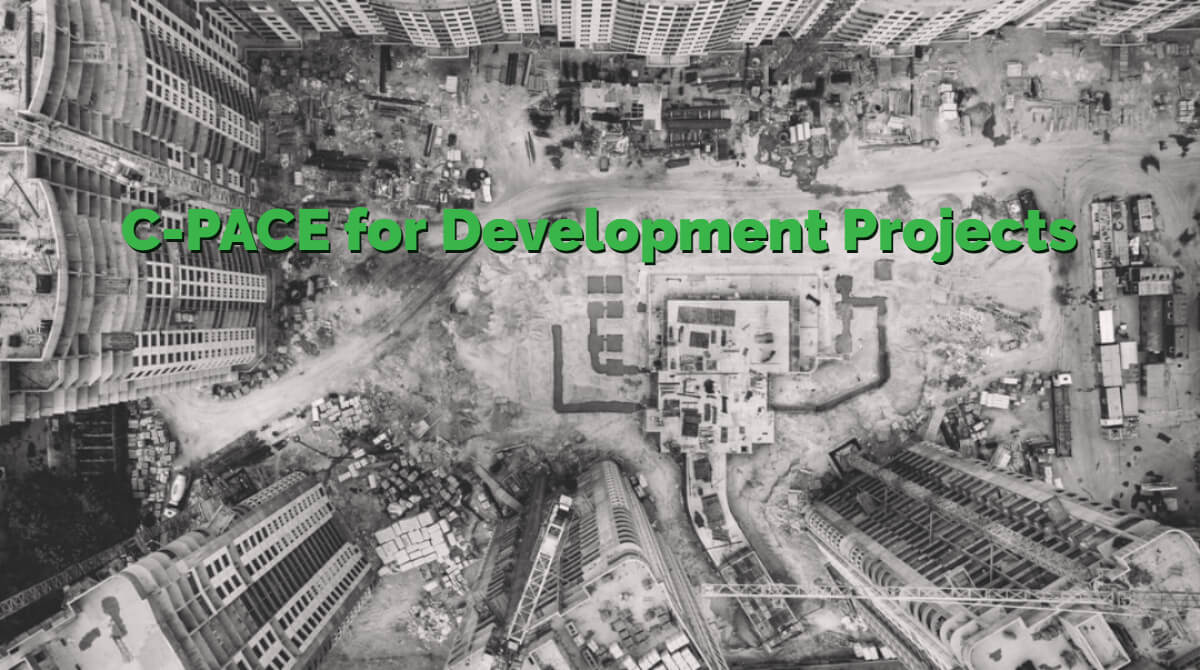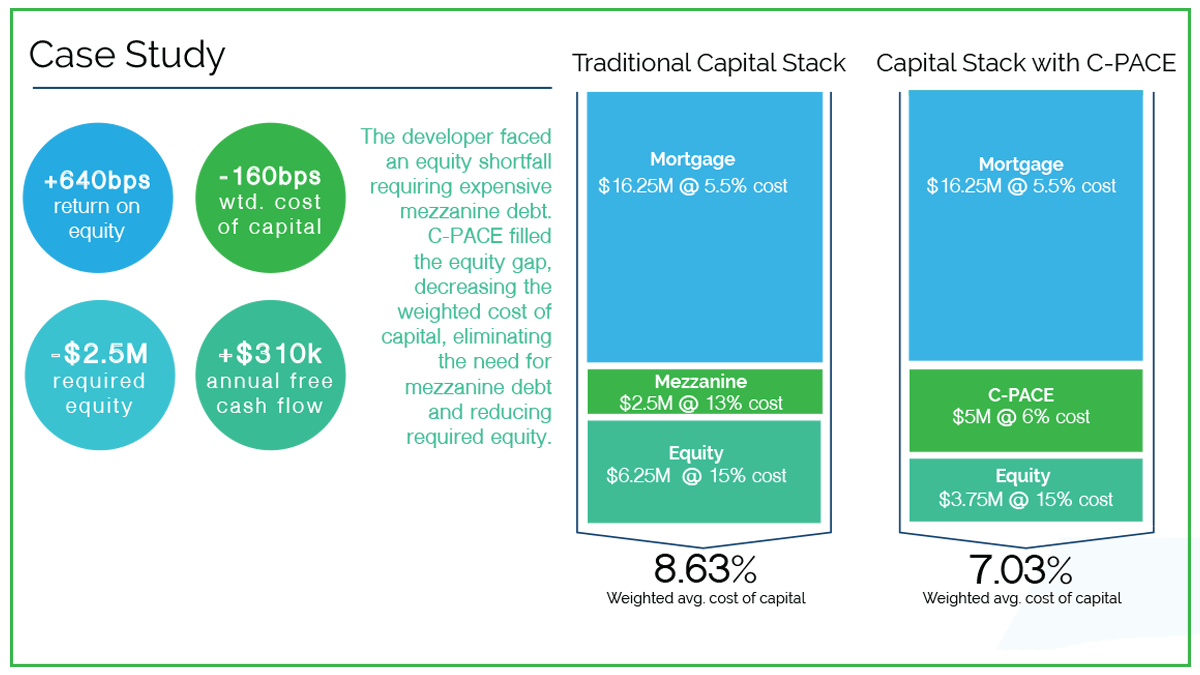
C-PACE for Development Projects
For nearly ten years, C-PACE has been financing green retrofit projects to existing buildings. Over the last 24 months, C- PACE has seen rapid growth as a financing tool for development projects, including ground-up construction and gut rehabilitation of vacant properties. The C-PACE industry is on track to surpass $1.0 billion in 2019, with much of the growth driven by developments. Ground-up construction alone comprised 24% of C-PACE financings closed in 2018, up from 16% in 2017 and 10% in 2016, according to PACENation data.
The rapid growth of C-PACE for development projects is driven by its financial power: C-PACE can often improve developer internal rate of return (IRR) by 50%+. The tool is so accretive to financial returns because it provides developers up to 30% of their capital stack at rates that are less than half the cost of traditional mezzanine debt or equity, as well as increased flexibility around sale and refinancing and incentives to build more sustainable properties.
C-PACE also unlocks powerful public policy benefits for development projects. Nearly all the active C-PACE programs in the country have enabled C-PACE for new construction, as commercial development projects face increasingly tougher hurdles to complete – such as stringent building codes and rising construction costs. The financial savings generated through C-PACE often enable these projects to pencil without the value-engineering that so often eliminates energy conservation measures (ECMs). Many states and municipalities see C-PACE as a “carrot” to reward building owners for complying with the “stick” of ambitious clean energy goals and strict building codes for commercial buildings, as seen with New York City’s Climate Mobilization Act passed in 2019.
Advantages of C-PACE for Developers
Developers across virtually all building types – including hotels, multifamily, office, retail, and industrial – are eager to capitalize on the benefits of C-PACE, as discussed in more detail below.
Reduced Cost of Capital
C-PACE can fill up to 30% of the new development capital stack at a fixed rate around mid-5 to mid-6 percent (lower for select markets and assets). It is by far the least expensive capital for this portion of the capital stack. By replacing mezzanine debt or equity for approximately half the cost, C-PACE dramatically improves the return on equity for developers.

A simple capital stack might include 50-65% senior debt with 20-25% C-PACE, with minimum sponsor equity of 10%. This is a widely adopted model particularly in the hospitality sector where senior lenders are often capped at a lower loan-to-cost. C-PACE can also complement more complex capital stacks including ground leases and tax credits.
Increased Flexibility
The flexibility of C-PACE is often underappreciated compared to the cost of capital savings. C-PACE offers all the benefits of traditional fixed-rate permanent financing, but for a longer term of 20-30 years at the end of which there is zero balance remaining, eliminating interest rate risk and refinancing risk. The C-PACE financing is easily assumed by the next buyer since it automatically transfers with title. C-PACE does not carry any post-closing covenants around sales, refinancing, or permitted property uses, unlike alternative financing options.
Should the developer choose to prepay the C-PACE assessment, it is open to full or partial prepayment at any time, subject to a declining fee schedule (typically starting at a low and fixed percentage of the loan balance stepping down every 3-5 years). There is no lock-out period or yield maintenance, unlike many mortgages and EB-5 financing. The C-PACE component can be unwound at any time, unlike ground lease financing which is often locked in for 99 years and results in a diminishing property value over time. This transfer and prepayment flexibility is especially attractive to short-term hold developers who may choose to exit the investment following stabilization.
Finally, at the landlord’s option, C-PACE can be passed through to hotel guests or tenants under certain lease structures. This flexibility may allow the developer to offset all, or a portion of, the cost of the C-PACE financing.
Non-Recourse Post Construction
C-PACE financing is non-recourse to the developer following project completion. In order to ensure timely completion of the project, Greenworks requires a completion and payment guarantee from the developer during construction, subject to net worth and liquidity requirements. This guarantee rolls off at project completion.
Better Buildings
Often, Greenworks clients choose to include or upsize C-PACE funding to cover higher-than-expected construction costs and prevent cuts to the project scope. Developers face significant pressure from rising construction costs, notably for steel, aluminum, lumber, and labor. C-PACE’s lower cost of capital enables development projects to pencil that would otherwise have stalled or potentially seen ECMs like high efficiency or smart glass windows, building controls, green roofs, solar, or EV charging stations cut from the budget through value engineering. The result is more efficient buildings that are better positioned to compete for quality tenants, many of whom are increasingly focused on sustainability and building health for employees.
Sizing C-PACE Proceeds for New Developments
Most C-PACE programs require that eligible measures meet or exceed existing building code by a small margin, say 5%, but standards vary across the county. The financing is increasingly being used as a public policy tool to ease adoption of more stringent building codes for both existing buildings and new construction.
Unlike many narrower energy efficiency programs, C-PACE can fund a wide array of hard, soft, and associated costs. If an ECM (i.e. windows) is deemed eligible based on program requirements, the entire cost of that measure (materials, installation, associated hard and soft costs) can be funded through C-PACE. On average, about 40% of new development project costs qualify as C-PACE eligible measures, so C-PACE financing proceeds are usually limited by underwriting criteria, not eligible costs. Greenworks sizes C-PACE proceeds based on a maximum stabilized loan-to-value of 20% (25% in select markets) and minimum sponsor equity of 10% of cost. This means in a typical C-PACE development project, C-PACE loan-to-cost will be under 30% of the capital stack. C-PACE financing can be amortized over the full useful life of the ECMs funded, so long-lived measures like the building envelope, windows, and elevators are often selected to maximize the term of the C-PACE financing and minimize the annual assessment payment.
Lender Consent for C-PACE in New Developments
Unlike operating buildings which often have in-place financing, sponsors for new development projects are typically assembling their capital stack from scratch. Greenworks recommends bringing C-PACE into the project early because construction lenders will need to consent to the C-PACE benefit assessment on the property. Senior construction lenders are more willing to consent to C-PACE if it means winning the deal in a competitive process, while lenders that have already taken a deal through their full credit committee process may experience heartburn reviewing the inclusion of C-PACE prior to close. Greenworks can assist with prospective lender calls and, in some cases, refer the sponsor to senior lenders who have approved C-PACE and may have interest in the project. Note that C-PACE does not work well with CMBS, SBA, or Fannie Mae loans.
Generally speaking, lenders want to understand how C-PACE impacts (i) their ability to foreclose on the property and (ii) their take-out at loan maturity. First, C-PACE does not impact a senior lender’s ability to foreclose on the property. Even if there is a C-PACE default due to non-payment, C-PACE runs through the existing statutory process for tax foreclosure / tax sale, which is typically one year or longer, giving the senior lender ample time to cure the default by covering the missed payment(s). A crucial nuance of C-PACE financing is also that it is non-accelerating; only amounts delinquent on the tax or assessment roll are enforced through existing statutory procedures while future assessment charges can never be called due. Second, lenders look for a value cushion at their exit, measured as the projected loan-to-value or projected spread between debt yield and market cap rate. Credit is typically given for those projects where the C-PACE assessment charges can be passed through to tenants or hotel guests.
To increase senior lender comfort, Greenworks can fund 100% of its proceeds into an escrow account at closing, providing evidence of a fully capitalized deal. Funds are disbursed based on a milestone-based disbursement schedule and are generally funded pro rata with the senior loan. The senior lender can also require the C-PACE payments be added to its tax and interest escrows.
To date, over 200 lenders have consented to C-PACE, including national, regional, and community banks, debt funds, and life insurance companies. While larger banks may be slower to adopt formal guidelines on C-PACE, certain banks have approved C-PACE at the regional level, or have approved policy exceptions for C-PACE until formal guidelines are adopted. Bank lenders will generally require at least 15% sponsor equity so their loan will not be classified as High Volatility Commercial Real Estate (HVCRE). Debt funds tend to be the most flexible when it comes to structuring and approvals. Once a lender has approved C-PACE for its first project, it is generally willing to work alongside C-PACE on future projects.
Finance Your Development Project with Greenworks
If you are interested in using C-PACE for your development project – or would like to learn more, let us know!
Greenworks Lending is the leading provider of C-PACE financing in the country. Our founders launched the country’s first successful C-PACE program and have brought their expertise and know-how to Greenworks Lending. We launched a dedicated “new construction” product in 2018 and pride ourselves in our transparent, rapid approval process. Our dedicated team is ready to assist with all aspects of a C-PACE financed project.
